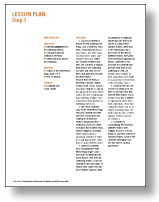

Click on the icon for Lesson 1 in Adobe Acrobat Format (55K).
Includes copies of the take-home page.
WHY OBJECTS?
Objectives
- Identify general reasons for collecting objects.
- Compile a personal collection inventory.
- Define personal reasons for collecting.
Materials
- Copies of the Take-Home Page (English or Spanish).
- Pens or pencils.
Subjects
- Language arts, social studies
Procedure
1. Ask your students if they have ever collected anything, such as feathers,
coins, dolls, or baseball cards (you may want to use other examples that
better reflect your students' interests). Select two or three student volunteers
and ask them to explain their reasons for collecting. Answers will vary,
but students will probably conclude that they collect objects because they
see them as beautiful, valuable, unique, useful, or old. (Some students
may find it difficult to explain the appeal of the objects they collect.
Be sure to emphasize that collecting is often a personal matter that depends
on individual interests.)
2. Give each student a copy of the Take-Home Page. Tell your students
that they will now survey their own collections of personal objects. Emphasize
that a collection can be any series of objects that students enjoy, without
regard to monetary value. (If time allows, encourage students to bring in
a sampling of their collections to share with the class.)
3. After your students have completed the Take-Home Page, begin a
class discussion to determine the many reasons they have for collecting
objects. Ask your students to tell what kinds of objects they collect and
why those objects appeal to them. If students have difficulty expressing
why they have chosen to collect these specific objects, refer back to the
Introduction for a discussion of the reasons different objects have great
value (historical significance, beauty, usefulness). You may find that students
will provide other reasons for collecting as well. (If students have brought
in their collections, now would be a good time to show them to the rest
of the class.)
4. Continue the class discussion by asking your students to describe
how they care for their objects. (Some students may find it difficult to
explain how they protect their collections. Stress that caring for objects
can be as simple as keeping them out of the rain, the sun, or their younger
brothers' and sisters' hands.)
5. Conclude by summarizing the value that different objects have.
Suggest that, just as many things in museums were once ordinary objects,
some of the students' belongings may one day take on historic importance.